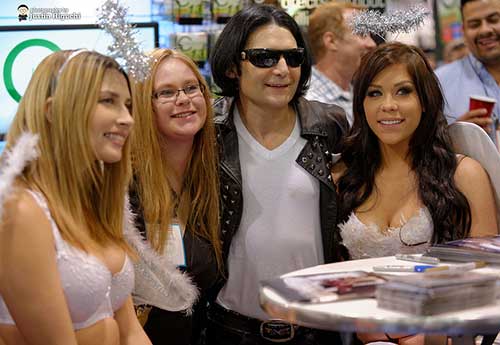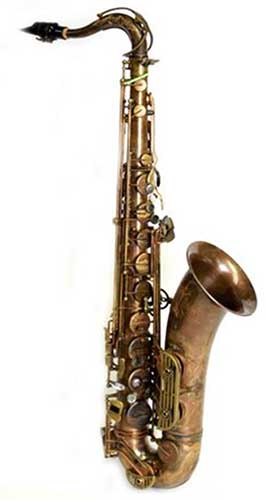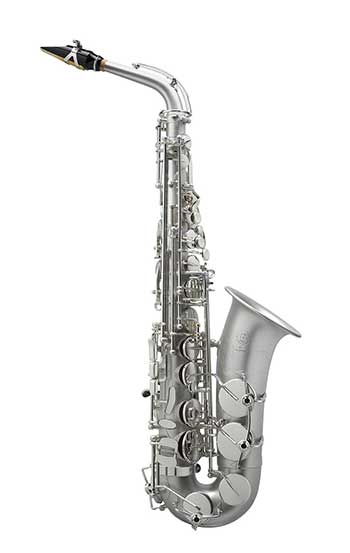
 This article is part 2 in a 3-part series covering the latest and greatest saxophone products shown at NAMM 2015. In case you missed it, click here for part 1.
This article is part 2 in a 3-part series covering the latest and greatest saxophone products shown at NAMM 2015. In case you missed it, click here for part 1.
Note for Mobile Users: Normally it’s not a big deal, but for this particular series of articles, I thought I’d mention – you’ll be seeing some ad banner images mixed in with the product images in this article, so keep in mind that any image with the word “Sponsored” directly above it is an ad and not part of the article (will try to think of a more elegant solution for the future).
Part 1 was just the beginning, here is the second installment, with products listed in no particular order.
SAXWORKS Ligature
 Throughout 2014, I saw more and more players using this SAXWORKS Ligature, and the overall response has been great. This year, I was able to meet with its creator, Joel Harrison. This lig, like the Compass by Claude Lakey, is designed to fit most common saxophone and clarinet mouthpieces. All the parts that make up this ligature are gold plated brass, and each one comes with a Universal Flex-Cap. It only makes one point of contact, and uses a gold-plated brass reed plate to improve the overall response. I found that the SAXWORKS Ligature fit my mouthpiece well, but it initially took a few minutes to adjust it because it’s a fairly large ligature.
Throughout 2014, I saw more and more players using this SAXWORKS Ligature, and the overall response has been great. This year, I was able to meet with its creator, Joel Harrison. This lig, like the Compass by Claude Lakey, is designed to fit most common saxophone and clarinet mouthpieces. All the parts that make up this ligature are gold plated brass, and each one comes with a Universal Flex-Cap. It only makes one point of contact, and uses a gold-plated brass reed plate to improve the overall response. I found that the SAXWORKS Ligature fit my mouthpiece well, but it initially took a few minutes to adjust it because it’s a fairly large ligature.
I found that overall, the SAXWORKS, like the Silverstein, allowed the reed to vibrate freely, and I found I gain a bit more projection on this ligature compared to what I’m using for my current setup. If you are in the market for a new lig, I would put the SAXWORKS ligature on your list to try out.
More info:
http://www.sax-works.com
Cannonball Key Artist Series Saxophone
 I have played the Cannonball Big Bell Stone Series and The Vintage Reborn series in various finishes. When I heard about the Cannonball Key Artist Series, I knew I had to play test the tenor and alto, since I have not seen wood key touches on many saxophones unless it was a special request.
I have played the Cannonball Big Bell Stone Series and The Vintage Reborn series in various finishes. When I heard about the Cannonball Key Artist Series, I knew I had to play test the tenor and alto, since I have not seen wood key touches on many saxophones unless it was a special request.
Unlike the Cannonball Big Bell Stone Series, The Key Artist series uses a traditional bell combined with Cocobolo wood finger buttons, bell-to-body brace, and a wood thumb button to offer a warm and rich timbre. This model also contains nickel-plated brass resonators and blued-steel springs.
I have to say that The Key Artist Series is my favorite line of saxophones that Cannonball offers because I found it to have an even scale, the right amount of resistance, and overall was not as punchy as the other models but had a nice timbre that would nicely suit classical as well as jazz playing. It seems that each horn manufacturer has its various line of saxophones and one of those saxophones is in reference to a certain “vintage saxophone”. Although the Vintage Reborn would mostly be Cannonball’s line that would interest vintage Selmer players, I found the Key series to come even closer in my personal opinion to the “vintage sound” which I think most players are looking for in a saxophone.
More info:
http://www.cannonballmusic.com/keyseries.php
P Mauriat Master 97 Alto Saxophone
 Since the introduction of the Greg Osby 76 3rd edition alto saxophone, which was well received and in my opinion, the best alto that P Mauriat currently produces – comes the P Mauriat Master 97 alto saxophone.
Since the introduction of the Greg Osby 76 3rd edition alto saxophone, which was well received and in my opinion, the best alto that P Mauriat currently produces – comes the P Mauriat Master 97 alto saxophone.
When I initially heard about this alto, I thought it was going to be targeted towards classical players, but after play testing this alto, I can see either classical or jazz focused saxophonists checking this horn out. The P Mauriat Master 97 alto has such features as Pisoni pro pads, blued-steel springs and a sterling silver octave pips. The P Mauriat Master 97 alto had a nice warm sound that projected well and what most players said and I agree with had probably the best intonation of the P Mauriat alto saxophones.
I found while going through my overtone series that this saxophone was spot-on and I found it easy to adjust the pitch. Mechanically the horn reminded me of the Greg Osby model and felt great under my fingers. I hope P Mauriat is working on a Master 97 tenor for those players seeking a well-balanced tenor, and I expect to see more and more players checking out this alto saxophone.
More info:
http://pmauriatmusic.com/products/item/3-alto/108-master-97
Eastman 52nd street soprano
[No image at this time, will update later if image becomes available]
The Eastman 52nd Street tenor and alto saxophones have become very popular. This year, I was able to speak with Ralph Torres over at Eastman and he told me that they recently added the bari and soprano saxophones to the 52nd Street line.
The Eastman 52nd street soprano saxophone embodies many of the characteristics players enjoy in their alto and tenor counterparts, but what’s unique about this soprano saxophone is it has rolled tone holes on only the bottom 5 and the rest are drawn tone holes. The Eastman comes in a one piece body that has a straight neck as well as a curved neck which reminded me of the popular Yamaha 62 sopranos. I am glad to see the new additions to the Eastman 52nd street line, and for those who enjoy the altos and tenors, you should give the soprano and bari saxophone a play-test.
More info:
http://www.eastmanmusiccompany.com
Theo Wanne Shiva (A.R.T) Mouthpiece
 With the introduction of one of Theo’s new mouthpiece, named “Shiva,” the big announcement was of the new material Theo is using called A.R.T (Advanced Resonance Technology). Theo put a good amount of research into this material, and believes he has surpassed hard rubber in terms of resonance, tone and response.
With the introduction of one of Theo’s new mouthpiece, named “Shiva,” the big announcement was of the new material Theo is using called A.R.T (Advanced Resonance Technology). Theo put a good amount of research into this material, and believes he has surpassed hard rubber in terms of resonance, tone and response.
The Shiva mouthpiece was designed for players who were looking for more edge, but also a mouthpiece that played similarly to a Berg Larsen, Dukoff or Guardala. Unfortunately, I did not have a chance to sit down and really test play the new Shiva mouthpiece with the A.R.T material due to the large number of players already at the booth. I was, however, able to speak with various Theo Wanne artists and other players who all said if you are looking for a very bright mouthpiece, then you should look into the Shiva.
More info:
http://store.theowanne.com/products/shiva-tenor-art-saxophone-mouthpiece
Trevor James Signature Custom Raw XS
 Another horn that I was able to try this year was the Trevor James Signature Custom RAW XS tenor. The finish of the RAW XS compared to the RAW has quite a bit more hand polishing which gets it down to the raw brass, and in my opinion resonates a bit more than the RAW, although they are both great models.
Another horn that I was able to try this year was the Trevor James Signature Custom RAW XS tenor. The finish of the RAW XS compared to the RAW has quite a bit more hand polishing which gets it down to the raw brass, and in my opinion resonates a bit more than the RAW, although they are both great models.
I had tried these saxophones at the Bari booth last year but had a chance this year to test play the various Trevor James Signature Custom Finishes at the Trevor James Booth. I thought Trevor James had a great idea in which they brought a fully-overhauled Selmer Mark VI tenor and told players to test the Mark VI against one of their Signature Custom models to see which one they preferred. I took the challenge and compared a Trevor James Signature Custom Raw XS with a 6 digit Selmer Mark VI tenor.
I found that both horns played great and felt comfortable in my hands, but from an intonation, even scale, and overall tone standpoint, I actually found the Trevor James Signature Custom Raw XS to be the better horn.
Each horn is built in a pro sax shop in Lenham (UK). The model Trevor James I was test playing also had a new “vintage” neck which I found to have resistance not unlike that of the Selmer Mark VI I test played. I thought this neck really made the Trevor James Signature Custom Raw XS model very Mark VI-like, but with modern keywork and better intonation. I was overall very impressed with the Trevor James Signature Custom RAW XS tenor and can see why they have been so popular overseas. So it’s good to see that they are now gaining traction in the United States.
More info:
http://tjsaxes.co.uk
Nadir Saxophone mouthpieces
 I have seen and spoken to many players who enjoy playing on the various model Dave Guardala mouthpieces, and I have seen a few of the vintage Dave Guardala MB1’s sell on Ebay for well over $1000 dollars. I had a chance this year to meet Nadir Ibrahimoglu, who besides owning a very successful music shop in Europe, has been crafting and refining the Guardala mouthpieces.
I have seen and spoken to many players who enjoy playing on the various model Dave Guardala mouthpieces, and I have seen a few of the vintage Dave Guardala MB1’s sell on Ebay for well over $1000 dollars. I had a chance this year to meet Nadir Ibrahimoglu, who besides owning a very successful music shop in Europe, has been crafting and refining the Guardala mouthpieces.
Nadir offers mouthpieces called the “Dave Guardala Reborn”, as well as his own line of mouthpieces under his name. Although I traditionally enjoy playing on a hard rubber or metal link, I wanted to see how Nadir’s mouthpieces played. Nadir offers such models as the Crescent, MB II, BM, and FAT BOY MBII – each with their own tonal characteristics.
After speaking with Nadir, he told me to check out one of the mouthpieces that will be released soon. The piece Nadir gave me I believe was a FATBOY, but with a different facing. Although I prefer hard rubber mouthpieces, this mouthpiece was incredibly free blowing, took very little air to gain a full sound, and was easy to articulate. While playing through the horn chromatically, the mouthpiece offered an even scale, which was appealing since I find some metal mouthpieces tend to either get too bright or thin when you start playing in the palm keys. This was not the case with Nadir’s mouthpieces.
Overall, I can see that Nadir takes his work very seriously and will not display or offer a mouthpiece that is not playing up to his standards. If you are a “Guardala-holic”, and are looking to find the right model for you, check out some of Nadir’s mouthpieces, and I am sure you will find what you are looking for.
More info:
https://nadirsaxwinds.com/mouthpieces
So that’s it for this installment of Zach’s adventures at NAMM 2015. Stay tuned for Part 3 coming shortly! – Doron
The post The Definitive NAMM 2015 Saxophone Roundup – Part 2 appeared first on Best. Saxophone. Website. Ever..

 I purchased the
I purchased the  I have played the Forestone mouthpieces, reeds, and saxophones and have been very impressed by their consistency as well as the attention to detail. Forestone has teamed up with daCarbo, who is known for making high end brass instruments out of a carbon fiber compound, to introduce a daCarbo/Forestone saxophone neck.
I have played the Forestone mouthpieces, reeds, and saxophones and have been very impressed by their consistency as well as the attention to detail. Forestone has teamed up with daCarbo, who is known for making high end brass instruments out of a carbon fiber compound, to introduce a daCarbo/Forestone saxophone neck.


 I stopped by the DANSR booth and Sylvan Carton was nice enough to show me how the Vandoren Reed Trimmer worked. The Reed Trimmer looked like a simple way to repair damaged tips and increase the strength of reeds that may have already gotten a lot of use.
I stopped by the DANSR booth and Sylvan Carton was nice enough to show me how the Vandoren Reed Trimmer worked. The Reed Trimmer looked like a simple way to repair damaged tips and increase the strength of reeds that may have already gotten a lot of use. I revisited Marmaduke this year after have played his alto and tenor hard rubber mouthpieces, – which are nicely finished, hand-made, and designed to embody many of the characteristics of the vintage Meyer and Otto Link mouthpieces.
I revisited Marmaduke this year after have played his alto and tenor hard rubber mouthpieces, – which are nicely finished, hand-made, and designed to embody many of the characteristics of the vintage Meyer and Otto Link mouthpieces.























 Introduction
Introduction





























